During my journey on the Camino de Santiago de Compostela, choosing the right socks was a crucial factor to ensure comfort and prevent blisters. In addition to Injinji toe socks, I used Lorpen T3 Light Hiker Eco socks, a brand known for its advanced technology and high quality. I will share details about Lorpen, the T3 technology, and my personal experience with these socks during the 35 days of walking.
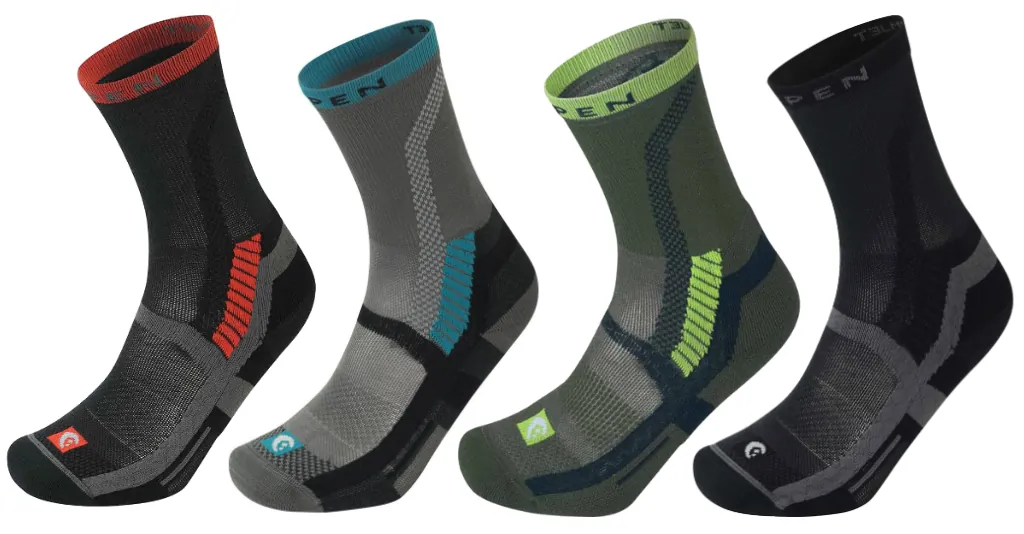
My story with the Lorpen brand
In 2010, I started managing the Lorpen brand in Brazil. During this period, I studied in depth the technology and quality of the products, and I was impressed by the raw materials used, such as Tencel, merino wool, Coolmax and Primaloft, as well as the knitting technologies applied to the socks. At that time, the technology now known as T3 was called TriLayer, being a major differentiator compared to other sock brands worldwide. Lorpen also had the Life Fit technology, which provided much more comfort due to the differentiated knitting of the socks. This technology is still present in Lorpen socks in four aspects: elasticity and adaptability, flat seam, different densities, and resistance and durability.
In Brazil, I developed some actions with the brand, including the campaign “Meus pés também vieram” (“My feet also came”), a photography contest that engaged consumers to share their outdoor experiences using Lorpen socks.

Image of one of the banners we used in Brazil in 2012
About the Lorpen brand
Lorpen is a Spanish brand founded in 1985 in the Pyrenees (Basque Country). Specialized in manufacturing technical socks for outdoor activities, Lorpen stands out for the innovation and quality of its products. The company’s mission is to create the best technical socks in the world, combining high-quality materials with advanced manufacturing technologies.
Lorpen is known for its exclusive technologies, such as T3 and SLS, which combine different layers of materials to offer maximum comfort, durability, and moisture control.
T3 technology in Lorpen socks
Lorpen T3 socks use exclusive technology that combines three different types of yarns, each with specific properties to maximize comfort, durability, and performance. T3 technology can be adapted for warm or cold climates, depending on the natural and synthetic fibers used.
For warm climates:
- Inner Layer: Synthetic yarn, usually Coolmax®, that stays in direct contact with the skin. This material is designed to wick moisture away from the body, keeping feet dry.
- Middle Layer: Natural yarn, such as Tencel®, that absorbs moisture and allows it to evaporate. Unlike cotton, Tencel® is effective in keeping skin dry and comfortable.
- Outer Layer: Nylon (polyamide), which provides resistance and durability to the sock. This layer protects against abrasions and increases the product’s lifespan.
For cold climates:
- Inner Layer: Synthetic yarn that may vary, such as Primaloft® or other materials that also help wick moisture away from the skin.
- Middle Layer: Natural yarn, such as Merino Wool, which provides thermal insulation and absorbs moisture, keeping feet warm.
- Outer Layer: Nylon (polyamide) for resistance and durability.
Benefits of Lorpen T3 technology
- Moisture Control: The combination of technical yarns helps wick moisture away from the skin, minimizing blister formation and keeping feet dry and comfortable.
- Comfort and Fit: Lorpen socks are designed to fit perfectly to the feet, providing additional support and reducing fatigue.
- Durability: High-quality materials and robust construction ensure that the socks withstand wear, even on long hikes.
- Sustainability: The use of natural fibers such as Tencel® or Merino Wool also contributes to a more sustainable production, aligning with Lorpen’s environmentally responsible practices.
Lorpen SLS technology
The SLS (Selective Layering System) technology allows combining in the same sock different numbers of layers in specific zones according to the activity’s requirements. Therefore, Lorpen’s SLS technology takes the brand and its socks to new limits in terms of knitting technology.
In the image below, we can see how Lorpen technologies are applied in a sock:
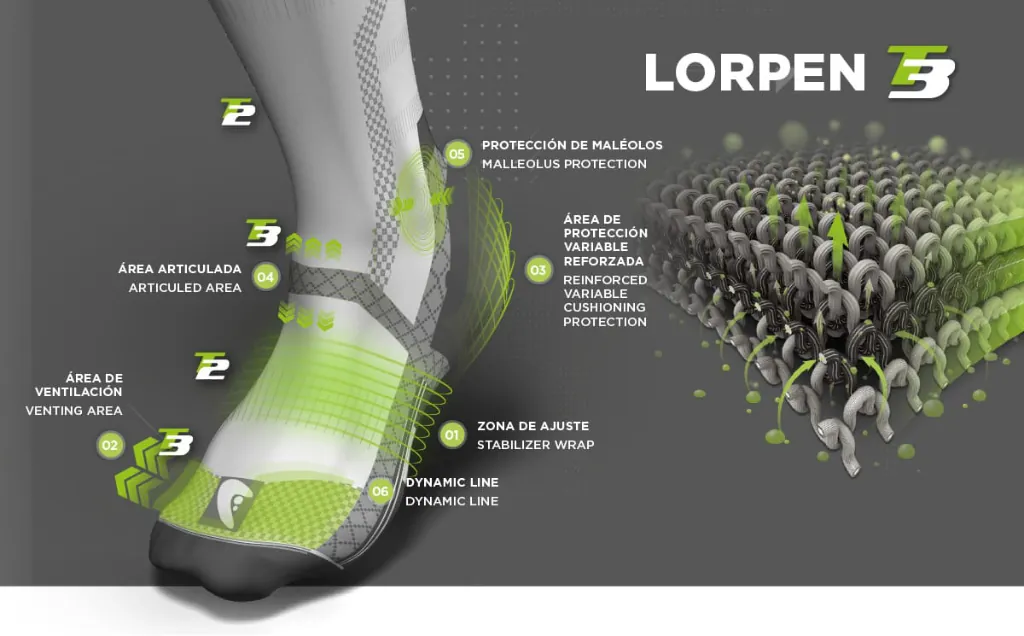
01 – Fit Zone refers to the part of the sock that wraps around the foot to provide a firm and secure fit. This area uses a larger amount of elastane (in this case, Lycra®) and a construction that allows the sock to adapt perfectly to the shape of the foot, preventing it from slipping during use. This is essential to prevent wrinkles and folds that could cause friction and eventually blisters.
02 – Ventilation Area is designed to improve air circulation inside the sock, allowing heat and moisture to escape more easily. This is achieved through the use of lighter, more breathable fabrics, strategically positioned in areas where ventilation is most needed. Good ventilation helps keep feet dry and fresh, reducing the chance of blisters caused by moisture buildup.
03 – Reinforced Variable Protection Area refers to the zones of the sock that receive additional cushioning to provide greater comfort and protection against impacts. These areas are strategically positioned in parts of the foot that experience more pressure and friction during activities such as hiking and running, like the heel and toes. This reinforcement helps reduce the chance of blisters and other discomforts by absorbing part of the impact and redistributing the pressure.
04 – Articulated Area is a design feature that allows greater flexibility and natural movement of the foot. This zone is constructed to follow the movements of the foot’s joints, providing a comfortable fit that does not restrict movement. This is especially important during intense physical activities, where freedom of movement is crucial.
05 – Malleolus Protection refers to the extra padding and reinforcement in the ankle area, specifically around the malleolus (ankle bone). This feature provides extra protection against impacts and abrasions, which are common during activities such as hiking on uneven terrain. The additional padding in this area helps absorb shocks and prevent ankle injuries.
06 – Dynamic Line is a design component aimed at providing additional support and stability to the foot. It is integrated into the structure of the sock to ensure a firmer fit and that the sock stays in place during intense activities. This not only improves comfort but also helps prevent excessive friction that can lead to blisters. The Dynamic Line acts as a support system that follows the natural movements of the foot, providing a greater sense of security and control.
Personal Experience with Lorpen T3 Socks
During the Camino de Santiago, I used the Lorpen T3 Light Hiker Eco model. This choice was based on the combination of comfort, moisture control, and durability offered by T3 technology. My daily routine included regularly changing socks and applying Akileine’s NOK cream to prevent blisters, and Lorpen socks played a key role in keeping my feet healthy throughout the 800 km covered. They were part of a “sock system” I used, which included, as I mentioned at the beginning of the text, an Injinji sock underneath the Lorpen sock. I did this to ensure my feet would stay as dry as possible, since I sweat a lot.
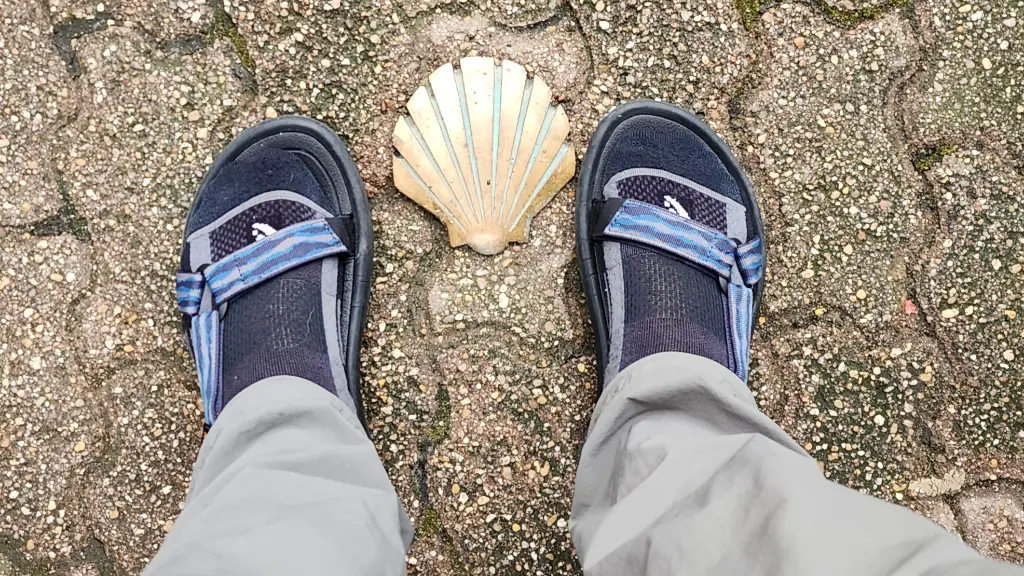
Airing out the feet on a cold day
T3 Light Hiker Eco Model Specifications
The Lorpen T3 Light Hiker Eco sock is designed for hiking journeys (day hike or multi-day hike) in warm climates. It combines several advanced technologies (T3 and SLS) and sustainable materials to provide comfort and protection.
Technical Composition:
- 44% Red-Cycled Nylon
- 29% Coolmax ECO
- 16% Stretch Nylon with Lycra
- 11% Tencel
Legal Composition:
- 58% Polyamide
- 29% Polyester
- 11% Lyocell
- 2% Elastane
*The technical composition provides detailed information about the types of yarns and materials. The legal composition refers to the net quantity of materials. In socks with yarns composed of more than one material, there may be differences between both compositions.
Materials used in the Lorpen T3 Light Hiker Eco sock

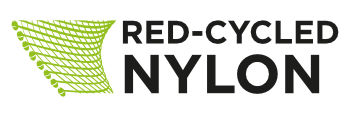
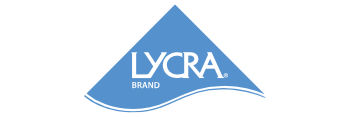

Main Features of the Lorpen T3 Light Hiker Eco sock
- Height: Crew (mid-height, reaching halfway up the calf)
- Reinforcement: Reinforced toe and heel
- Cushioning: Cushioned toe and heel
- Seasons: Fall, Spring, and Summer
- Thickness: Medium (2/4)
Conclusion
The Lorpen T3 Light Hiker Eco socks are an excellent choice for anyone planning to take long hikes or outdoor activities. The advanced technology and high-quality materials ensure your feet stay dry, comfortable, and blister-free. My experience on the Camino de Santiago de Compostela confirmed the effectiveness of these socks, making the journey more enjoyable and pain-free.
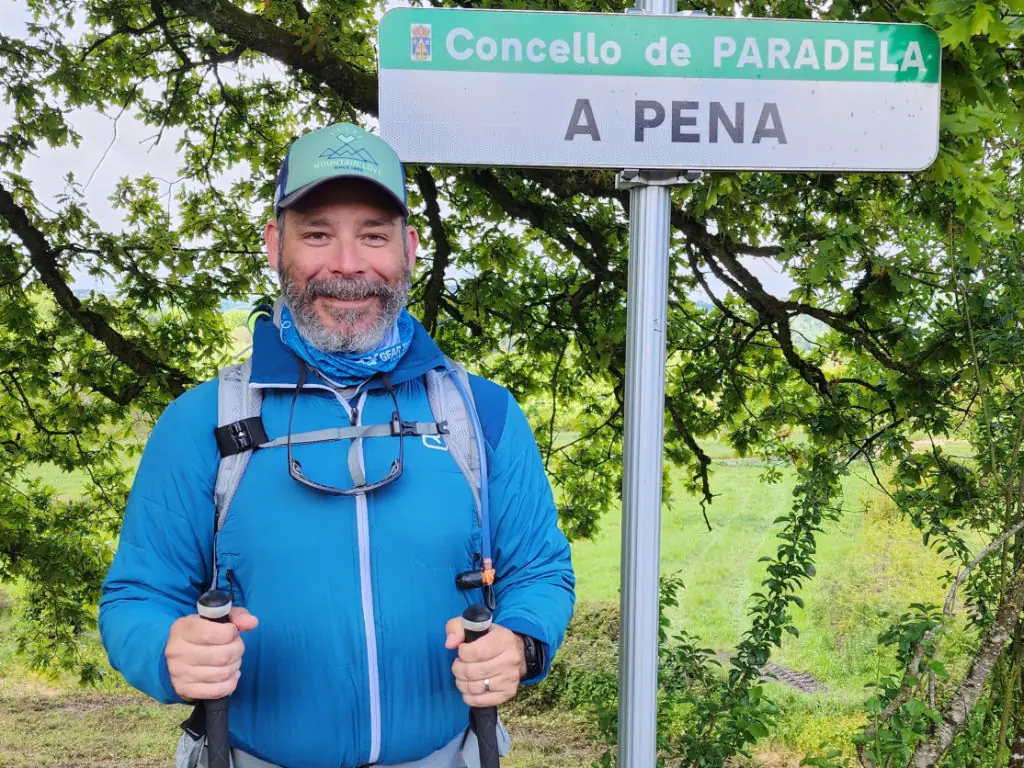
Lorpen socks: worth using!
Want to know more about Lorpen? Visit: lorpen.com
This post is also available in: Português (Portuguese (Brazil)) Español (Spanish)
